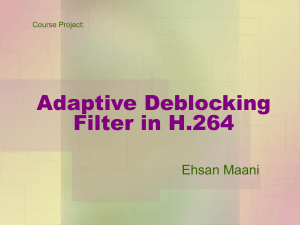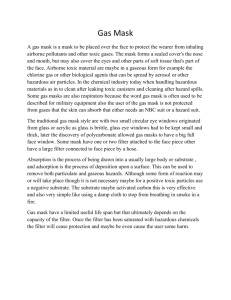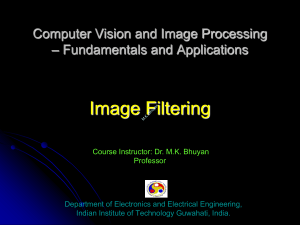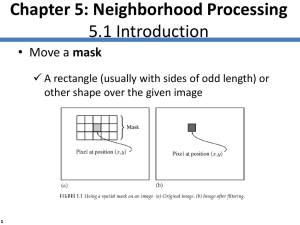PPT file
advertisement
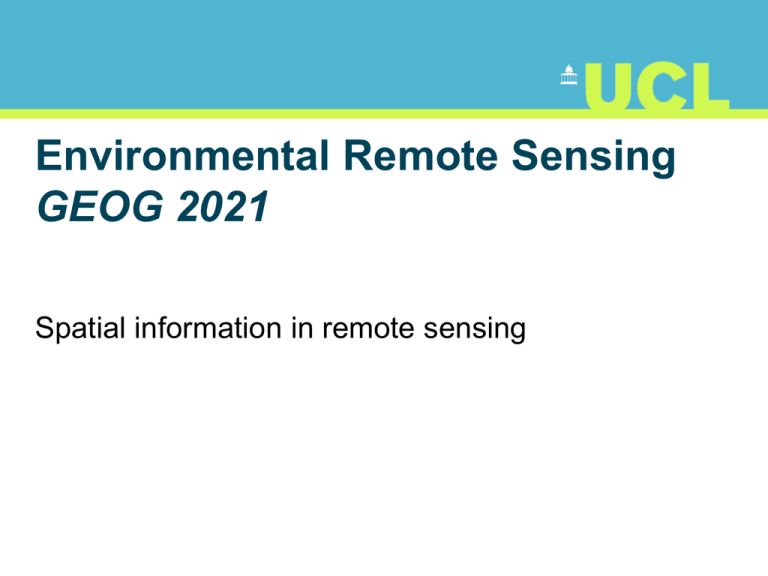
Environmental Remote Sensing GEOG 2021 Spatial information in remote sensing Aim • Recognising spatial information in EO images • Improve our ability to interpret remote sensing data by image processing • Typical operations – smoothing – edge detection – segmentation • and some terminology 2 Why process images ? • Improve interpretability – Enhance image, smooth, remove noise, improve contrast…. • Detect particular spatial features – edges of fields or woodland – ship wakes on the ocean surface – power lines ? Airport runways ? 3 • Images are presented as 2-d arrays. Each pixel (array element) has a location (x,y) and associated with it a digital number (DN). • Can think of the DN as the value of a function F(x,y) 0 F(4,1) 0 0 2 0 2 3 4 2 2 6 9 2 2 9 12 F(2,3) 4 • Consider a single line of an image:0012353221283210… ... • which can be represented as Bright (high DN) 5 • Consider following set of operations (which we’ll do first, and then think about afterwards…) • Place a mask (3 pixels long) over the start of the sequence – multiply the numbers in the array by the numbers in the mask – add them together – divide by the number of cells in the mask:- mask 0012353221283210… ... 111 – 0*1 + 0*1 + 1*1 = 1 – divide by 3 1/3 6 – move the mask along one and repeat... 0012353221283210… ... 111 – 0*1 + 1*1 + 2*1 = 3 – divide by 3 1 1/3 1 – and repeat… 0012353221283210… ... 111 – 1*1 + 2*1 + 3*1 = 6 – divide by 3 2 7 0 0 12 3 53 22 1 2 83 210… ... 1/3 1 2 3.3 3.7 3.3 2.1 1.7 1.7 3.7 4.3 4.3 2 1 8 • The series of operations we have carried out is called “convolution filtering” • Convolution transforms an input function (in this case a 1D array) into an output function (in this case another 1D array) using an operator function (the filter – also a 1D array) input filter output 9 0 0 0 3 3 3 2 3 3 3 1 1 1 0 1 The filtering we’ve done seems to have “smoothed” the 1D profile 10 • This is an example of a “smoothing” filter. It proceeds by calculating average (mean) values. Therefore it will smooth away deviations • Sometimes called “running mean” or “moving average”. • Note that smoothing filters “blur” the features in an image • loss of spatial resolution – So why do we do it?? 11 • The generalisation to 2D arrays (images) works in exactly the same way… • except that we now use a mask that’s also a 2D array:- 1 1 1 0 0 0 2 1 1 1 0 2 3 4 1 1 1 2 2 6 9 2 2 9 12 12 unsmoothed running mean 3x3 running mean 5x5 13 • Notice that we have a buffer around the edge, where we cannot quite apply the mask • There is another important way of calculating the mean value - median. • What does a median filter do? • What advantages are there compared with the mean? 14 • The mask we are using is called the kernel • So far are simple – Value of 1 in every cell of a 1x3 or 3x3 kernel • But we can very easily complicate the kernel • In this case the output of the filter will be very different • e.g. what happens with this kernel? -1 0 1 15 0 0 0 3 3 3 1 1 1 0 1 3 0 0 0 3 3 3 1 0 3 -1 0 1 2 3 Mean filter 3 0 1 0 “1st derivative” filter 16 • 1st derivative filter calculates gradient. • Where DN values constant (gradient=0) filter =0 • Only starts returning values where there is a gradient (i.e. where DN values change from one pixel to the next) • Returns high values wherever change in DN is high • Use to detect edges since these are often visible in an image where there is a change in brightness 17 • Can again apply to 2D images • For the edge detecting kernel, we might have -1 0 1 -1 0 1 -1 0 1 -1 or -1 -1 0 0 0 1 1 1 • What is the different between these, and what effects are they likely to have ?? 18 -1 0 1 -1 0 1 -1 0 1 • This filter has – smoothing in the y direction – gradient operator in the xdirection – “combination” of two filters • It won’t do the same thing as the second kernel 19 Directionality • Note that when we work with 2D images, we can introduce filters that are not isotropic (that is, the kernels have different numbers in the x-y directions) • horizontal and vertical smoothing • horizontal and vertical edge detectors 20 horizontal edge detection vertical edge detection 21 Convolution • One way of describing the filtering operations we have been doing is to use the term “convolution” • Convolution of an image with a kernel (moving the mask around on the image and multiplying them together) • O=FI • where I represents the input, and O is the output. 22 • Note that we are free to do more than one filtering operation:• O = (F2 (F1 I)) • which effectively means “do the filtering operation 1 on the input I, and then on the output of this, do another filtering operation (2) to give the final output O”. 23 Sobel • Another edge detecting filter is the Sobel filter:- -1 0 1 -2 0 2 -1 0 1 or -1 -2 -1 0 0 0 1 2 1 • Combinations of smoothing and gradient operator • Again there is a vertical version, and a horizontal version 24 • If 1st order derivative filter calculates gradients in an image, we can also calculate gradients in the gradient image (2nd order) • Rather than doing two separate filtering operations, we can instead use a single filter to do the whole job • Called a “Laplacian” 25 0 0 0 3 3 3 3 -1 0 1 0 1 0 0 0 3 3 3 3 1 -2 1 1 0 0 “1st derivative” filter 0 1 -1 0 0 “2nd derivative” 26 • Laplacians detect “the edges of the edges” 0 1 0 1 -4 1 0 1 0 27 Low- and High-Pass Filtering • When we look at spatial structure, we can usually see a characteristic length scale (e.g. size of fields, width and length of roads, etc) • Images usually have features on lots of different length scales 28 • Sometimes, instead of talking about “length scale”, we talk instead about “spatial frequency”. • High frequency variation == changes in DN over small distance • Low frequency variation == changes in DN over large distance 29 • e.g. Smoothing filters • remove small scale features but maintain large scale features • i.e. remove (smooth out) high spatial frequencies from the image, but keep low spatial frequencies • “low pass” filter 30 • Similarly, edge detectors keep small scale features, but remove large scales • “high pass” filter 31



